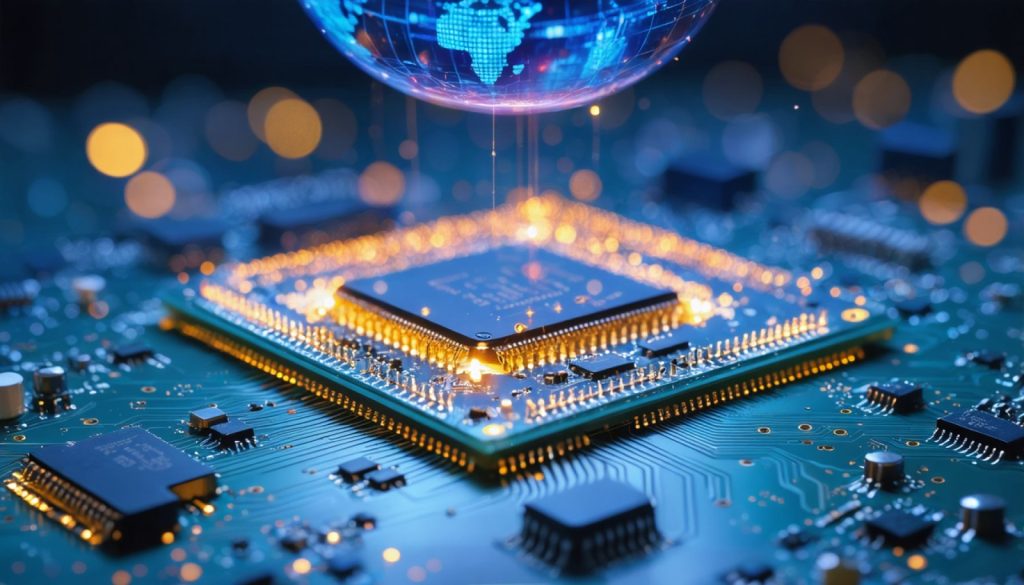
- Alphawave’s 2024 annual results reveal no future guidance due to global geopolitical and economic uncertainty.
- The semiconductor industry lies at the intersection of technological innovation and international political tensions.
- Semiconductors are crucial components in various sectors, making them key players in global strategic conflicts.
- China’s role in the semiconductor market is shaped by evolving trade policies from previous U.S. administrations.
- Companies in this field must balance technical innovation with navigating unpredictable international relations.
- Adaptability to change is vital as firms face challenges linking rapid tech advancements with shifting global dynamics.
A distinct unease shadowed the words echoing through the corridors of power and commerce this past week: uncertainty. This sentiment, prevalent in financial accounts and trading updates, echoes the complex world of semiconductor development—a field where geopolitics and innovation collide dramatically.
Alphawave, a prominent player on the London Stock Exchange, recently unveiled its annual results for 2024, bringing to light a critical decision. Faced with immense global instability and the fluid complexity of newly imposed tariff regimes, the company refrained from offering guidance for future performance. This move highlights the labyrinthine challenges technology companies face amid today’s geopolitical landscape.
As the semiconductor industry pulses at the heart of technological advancement, it also stands at the forefront of international scrutiny and strategic contention. Semiconductors—the engines driving everything from smartphones to sophisticated defense systems—have become pawns in a larger geopolitical chess game. Chris Miller’s insightful work, Chip War, meticulously dissects these nuanced tensions, placing semiconductors at the strategic crossroads where nations clash.
Alphawave’s expansive commercial networks lay bare the industry’s dependency on Asian markets, where the balance of power delicately hinges. China, a significant player in this arena, remains the focal point of intensified trade policies initiated during the Trump administration. This ever-evolving commercial choreography means companies like Alphawave must navigate not just technical hurdles, but also the unpredictable winds of international diplomacy and economic policy.
For Alphawave, this uncertainty drives a narrative familiar to many in the semiconductor space: innovate locally, think globally, but always brace for change. It’s a modern tale of adaptation as firms worldwide grapple with the challenges of aligning rapid technological advancements with fluctuating international relations.
The key takeaway? In a rapidly changing world marked by strategic realignments and economic unpredictability, the semiconductor industry epitomizes the intersection of innovation and international jeopardy. Companies entrenched in this space must be as agile as the technologies they create, ready to pivot in response to the volatile global stage they inhabit. As this silent turmoil unfolds, the ability to adapt quickly and intelligently offers the surest path through the fog of uncertainty.
Navigating the Semiconductor Chessboard: Strategies Amid Global Uncertainty
Understanding the Semiconductor Industry in Geopolitical Context
The semiconductor industry is central to technological innovation, impacting every sector from consumer electronics to national defense. However, the geopolitical landscape significantly affects the industry’s dynamics, shaping its development in complex ways.
The Geopolitical Chessboard
1. Role of Major Players:
– China: As a critical player in the semiconductor market, China’s strategies often influence global supply chains and technological advancements. These actions include significant investments in domestic semiconductor capabilities and efforts to reduce dependency on foreign technology.
– United States: U.S. policies have historically attempted to curb China’s technological rise, often through tariffs and export restrictions on critical technologies.
2. Tariff Regimes and Trade Policies:
– The semiconductor industry faces fluctuating tariffs and trade policies, heavily influenced by political changes. For instance, the trade policies initiated during the Trump administration have persisted and evolved under the current administration, affecting how companies like Alphawave operate.
How Companies Are Responding
1. Strategic Adaptation:
– Firms are investing in local R&D and manufacturing to mitigate risks associated with international supply chains. This approach is crucial for adapting to sudden changes in trade policies or geopolitical tensions.
2. Technological Innovation:
– Innovation in chip design and manufacturing processes remains a top priority, as firms strive to create cutting-edge products that can dominate global markets and reduce production costs.
Insights from “Chip War”
Chris Miller’s “Chip War” illustrates the stakes involved as nations vie for technological supremacy. He discusses how semiconductors are not just components but strategic assets in this ongoing rivalry.
Emerging Trends and Market Forecasts
1. Expansion of AI and IoT Devices:
– The growth in AI and IoT applications continues to drive demand for more sophisticated semiconductors, aligning with the estimated growth trajectory in these sectors.
2. Sustainability and Security:
– With increased focus on sustainability, companies are investing in eco-friendly manufacturing processes. Simultaneously, as cybersecurity threats evolve, there is a critical need for secure semiconductor technologies.
Key Challenges and Limitations
1. Supply Chain Vulnerabilities:
– The COVID-19 pandemic highlighted vulnerabilities in global supply chains, prompting a reevaluation of dependencies on specific regions or materials.
2. Regulatory Compliance:
– Navigating different regulatory environments poses challenges, particularly when aligning with diverse international standards and compliance requirements.
Actionable Recommendations
1. Diversification Strategies:
– Firms should diversify their supply chains and base operations across multiple regions to avoid over-reliance on any single market.
2. Investment in R&D:
– Continuous investment in research and development is crucial for staying ahead in innovation and maintaining competitive advantage.
For more insights into the dynamics of the semiconductor market and related technology fields, visit McKinsey & Company’s website and The Semiconductor Industry Association.
In conclusion, the semiconductor industry’s intricacies are deeply intertwined with geopolitics, requiring companies to be agile, innovative, and strategically minded to thrive amid uncertainty.



